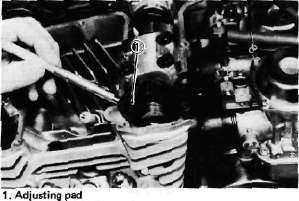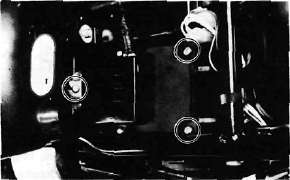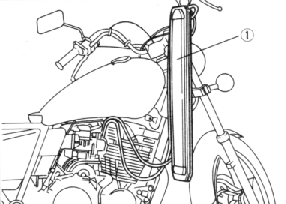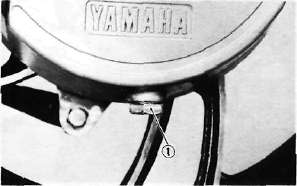Engine Maintenance
Engine Maintenance
ENGINE
A. Valve Clearance Adjustment
NOTE:-
Valve clearance must be measured with the engine and at room temperature.
1. Remove the seat and fuel tank.
2. Remove the horn, flasher relay, and spark plug lead wires.

3. Remove the cylinder head cover and left crankcase cover (pick-up base cover). Care should be taken to not scratch or damage the gasket sealing surfaces,
4. Turn the crankshaft with the nut on the left end of the crankshaft to turn the cams. The proper position of the cam when measuring the valve clearance is with the cam lobe directly opposite the valve lifter.

5. Insert a feeler gauge between the valve lifter and the camshaft base circle.

|
Intake valve clearance (cold): |
|
||
|
0.11- |
0.15 mm |
(0.004 ~ 0.006 |
in) |
|
Exhaust valve clearance (cold): |
|
||
|
0.16- |
-0.20 mm |
(0.006-0.008 |
in) |
Adjustment
Valve clearance is adjusted by replacing the adjusting pad on the top of the vale lifter. Adjusting pads are available in 25 thicknesses ranging from No. 200 (2.00 mm) to No. 320 (3.20 mm) in steps of 0.05 mm. The thickness of each pad is marked on the pad face that contacts the valve lifter (not the cam). Adjustment of the valve clearance is accomplished as follows:
1. Determine valve clearance (feeler gauge measurement.)
2. Remove adjusting pad and note number.
3. Select proper pad from appropriate chart (intake or exhaust chart).
4. Install new pad and check installed clearance.
Procedure
1. Measure valve clearance. If clearance is incorrect, record the measured amount of clearance. This must be measured carefully.
2. There is a slot in the valve lifter. This slot must be positioned opposite the blade of the tappet adjusting tool before the tools is installed.
3. Turn the cam until the lobe fully depresses the valve lifter and opens the valve. Install the tappet adjusting tool as shown to hold the lifter in this depressed position.
NOTE:
The tappet adjusting tool is fastened to the cylinder head securely using an alien screw. Make sure that the tool contacts the lifter only, and not the pad.
CAUTION:-
If the cam lobe touches the tappet adjusting tool, the stress may fracture the cylinder head. DO NOT ALLOW THE CAM LOBE TO CONTACT THE TAPPET ADJUSTING TOOL.

4. Carefully rotate the cam so that the pad can be removed. To avoid cam touching the adjusting tool, turn cams as follows: (view from left side of the motorcycle) Intake: Carefully rotate CLOCKWISE. Exhaust: Carefully rotate COUNTERCLOCKWISE.

5. Remove the pad from the lifter. There is a slot in the lifter. Use a small screwdriver or other blade and tweezers or a magnetic rod to remove the pad. Note the number on the pad.

6 Proper pad selection is made as follows:
Chart lookup method:
(Use appropriate chart for exhaust or intake valves, attached to this page, below.)
a. Find number of original (installed) pad number on chart. Read down on chart.
b. Find measured valve clearance (from step 1) on chart. Read across.
c. At the intersection of installed pad number (down) and measured clearance (across) is a new pad number.
EXAMPLE:
Intake valve, installed pad:
No. 250 (read down) Measured clearance:
0.32 mm (read across) New pad number: No. 270
(intersection of down & across)
Alternate shim calculation method:
Since all shims come in .05mm (.002") increments, you can quickly calculate the required size without a chart.
If the measured clearance is within 0.05mm (0.002") of the required clearance, then no change is needed.
If the measured clearance greater than 0.05mm (0.002") but 0.10mm (0.004") or less different than the required clearance then the next size shim is required.
If the measured clearance greater than 0.10mm (0.004") but 0.15mm (0.006") or less different than the required clearance then the next size shim is required.
Clearances that are too small require thinner shims. Clearances that are too large require thicker shims.
Example: Required exhaust valve clearance is 0.16~0.20mm. Measured clearance is 0.12mm (gap too small). Installed shim is Y270. Required shim is one size thinner: Y265.
NOTE:
The new pad number is to be used as a guide only. Verify the correctness of this choice in the following step(s).
7. Install the new pad in the lifter. Install the pad with the number down.
8. Remove tappet adjusting tool,
9. Turn crankshaft to rotate cam several rotations. This will set the pad in the lifter.
10. Check valve clearance (step 3). If clearance is incorrect, repeat preceding steps until proper clearance is obtained.
11. Inspect head cover gasket. If bent or torn, replace gasket.
12. Reinstall removed parts in reverse order.

This model has been equipped the automatic cam chain tensioner. No adjustment is necessary.
When installing this tensioner onto the cylinder proceed as follows:
1. Remove the end plug and spring from the tensioner assembly.
2. Unlock the oneway cam by pushing it with your finger and push the tensioner rod into the tensioner body until it stops.
3. Install the tensioner to the cylinder and torque the bolts to the specification.
Tightening torque: 1.0 m-kg (7.2 ft-lb)
4. Reinstall the spring and end plug with the gasket. Torque the end plug to the specification.
Tightening torque: 1.5 m-kg (11 ft-lb)
C. Ignition Timing
1. Ignition timing is checked with a timing light by observing the position of the stationary pointer and the marks stamped on the timing plate.
|
The timing plate is marked as follows: |
|
|
n |
... Firing range for No.1 (L.H.) |
|
T |
... Top Dead Center for No. 1 |
2. Connect the timing light to No. 1 (L.H.) spark plug lead wire.
3. Start the engine and keep the engine speed as specified. Use a tachometer to check the engine speed.
Specified engine speed: 1,050 r/min
4. The stationary pointer should be within the limits of "PI" on the timing plate. If it exceeds the limits or does not steady, check the timing plate for tightness and/or ignition system for damage. (See "CHAPTER 6. ELECTRICAL)
CAUTION:-
Never bend the stationary pointer.

D. Air Cleaner
1. Removal
a. Remove the seat.
b. Remove the tool tray.
c. Remove the air filter case cover by removing the three screws.

d. Pull out the element.

1. Air filter element
2. Cleaning method
Tap the element lightly to remove most of the dust and dirt; then blow out the remaining dirt with compressed air from the inner surface of the element. If element is damaged, replace it.

3. Reassemble by reversing the removal procedure. Check whether the element is seated completely against the case.
4. The air filter element should be cleaned at the specified intervals.
CAUTION:-
The engine should never be run without the air cleaner element installed; excessive piston and/or cylinder wear may result.
E. Carburetor
NOTE:
The carburetors are numbered 1, 2, 3, and 4 from the left when viewed from astride the motorcycle.
1. Idle mixture
The idle mixture is set at the factory by the use of special equipment. Not attempt should be made by the dealer to change this adjustment.
2. Synchronization
The seat must be opened and the rear of the tank elevated to gain access to the vacuum connections and synchronizing screw of the carburetors.
NOTE:
The valve clearances must be set properly before synchronizing the carburetors.
1. Remove the vacuum pipe from the carburetor manifold (No. 3 cylinder) and turn the fuel petcock to "PRI".
2. Remove the rubber caps from the No. 1, 2, and 4 carburetor manifolds.

1. Vacuum pipe 2. Rubber cap
3. Remove either the left or right (but not both) blind plug at the end of the YICS (Yamaha Induction Control System) passage in the cylinder.
4. Insert the YICS shutoff tool (special tool) fully and flip the locking lever.
5. Connect each vacuum gauge hose to its proper carburetor.

1. Vacuum gauge
6. Start the engine allow it to warm-up for a few minutes. The warm-up is complete when engine responds normally to the throttle opening.
7. Make sure the engine idle speed is 950 ~ 1,000 r/min. If it does not, adjust the idle speed with the throttle stop screw.
NOTE:
With the YICS shutoff tool fitted, the engine speed generally drops a little. Thus, continue with the following steps at idle speed of 950 ~ 1,000 r/min.
8. Each gauge reading will indicate the same if the carburetors are synchronized. The No. 3 carburetor has no synchronizing screw and the other carburetors are to be synchronized to it in order, one at a time.
First, synchronize carburetor No. 1 to carburetor No. 2 by turning the No. 1 synchronizing screw until both gauges read the same.
Second, in the same way synchronize carburetor No. 4 to carburetor No. 3. Third, by adjusting No. 2 screw to watch No. 3 carburetor reading, No. 1 and No. 2 carburetors will both change to match No. 3 carburetor.

1. Synchronizing screws
9. Remove the YICS shutoff tool and reinstall the blind plug.
Tightening torque: 2.2 m-kg (16.0 ft-lb)
10. Check the idle speed. Adjust if necessary.
IDLE SPEED ADJUSTMENT NOTE:
Carburetors must be synchronized before setting final idle speed. The idle speed adjustment is made by turning only one throttle stop screw.
1. The engine must be warmed up before setting idle speed.
2. Set the engine idle speed by turning the throttle stop screw in (to increase engine speed) or out (to decrease engine speed).
Standard idle speed: 1,050 r/min

1. Throttle stop screw
F. Engine Oil
1. Oil level measurement a. Place the motorcycle on the center stand. Warm up the engine for several minutes.
NOTE:
Be sure the motorcycle is positioned straight up when checking the oil level; a slight tilt toward the side can produce false readings.
b. With the engine stopped, check the oil level through the level window located at the lower part of the right side crank-case cover.
NOTE:
Wait a few minutes until the oil level settles before checking.

c. The oil level should be maximum level. If the level is lower, add sufficient oil to raise it to the maximum level.
2. Engine oil and oil filter replacement
a. Start, the engine and stop it after a few minutes of warm-up.
b. Place an oil pan under the engine and remove the oil filler cap.
c. Remove the engine and middle gear drain plugs and drain the oil.

1. Engine drain plug

1. Middle gear drain plug
d. Remove the oil filter bolt and filter element.

1. Oil filter cover
e. Re-install the drain plugs (make sure they are tight).
|
Drain plug torque: |
|
|
|
Middle gear: |
1.6 |
m-kg (11.6 ft-lb) |
|
Engine: |
4.3 |
m-kg(31.0ft-lb) |
f. Install the new oil filter element, new "O-ring" and filter cover, tighten the oil filter bolt.
Oil filter bolt torque: 1.5 m-kg (11.0 ft-lb)
NOTE:
When installing the filter cover, make sure the "O-ring" is positioned properly and insert the locating projection on it into the corresponding guides on the crankcase.

1. Proper O-ring position
g. Add oil through the oil filler hole.
Periodic oil change: 2.35 lit (2.5 US qt.)
With oil filler replacement: 2.65 lit (2.8 US qt.)
Recommended oil:

h. After replacement of the engine oil, and/ or oil filter, be sure to check for oil leakage. The oil level indicator light should go off after the oil is filled.
CAUTION:-
If the indicator light flickers or remains on, the oil level switch may be damaged. Refer to "CHAPTER 6" for corrective action.
G. Final Gear Oil
1. Oil level measurement
a. Place the motorcycle on a level place and place it on the center stand. The engine should be cool (at atmospheric temperature).
b. Remove the oil filler cap and check the oil level whether it is to the hole brim. If it is not up to this level, replenish oil.
CAUTION:-
Take care not to allow foreign material to enter the final gear case.

2. Gear oil replacement
a. Place an oil pan under the final gear case.
b. Remove the final gear oil filler cap and the drain plug, and drain the oil.

1. Final gear drain plug
c. Reinstall and tighten the final gear drain plug.
d. Fill the gear case to the specified level.
Oil capacity: 0.20 lit (0.21 US qt.) Recommended oil: SAE 80 API "GL-4" Hypoid gear oil
If desired, an SAE 80W/90 hypoid gear oil may be used for all conditions.
e. Reinstall the filler cap securely.
H. Compression Pressure Measurement
Insufficient compression pressure will result in performance loss and may indicate leaking valves or worn or damaged piston rings. Procedure:
1. Make sure the valve clearance is correct.
2. Remove the headlight fuse from the fuse box.
3. Warm up the engine 2 ~ 3 minutes. Stop the engine.
4. Remove the all spark plugs.
5. Install a compression check gauge.
6. Turn over the engine with the electric starter (make sure the battery is fully charged) with the throttle wide open until the pressure indicated on the gauge does not increase further.
Compression pressure (at sea level):
Standard.......11 kg/cm2 (156 psi)
Minimum.......9 kg/cm2 (128 psi)
Maximum......12 kg/cm2 (171 psi)
WARNING:-
When cranking the engine, ground the removal spark plug wires to prevent sparking.

1. Compression gauge
7. If the pressure is too low, squirt a few drops of oil into the cylinder being measures. Measure compression again. If there is a higher reading than before (without oil), the piston rings may be worn or damaged. If the pressure remains the same after measuring with the oil, either or both the rings and valves may be the cause.
8. Check each cylinder. Compression pressure should not vary more than specified value from one cylinder to any other cylinder.
Difference in gauge reading: Less than 1 kg/cm2(14 psi)
I. Clutch Adjustment
Free play adjustment
a. Loosen either the handle lever adjuster lock nut or the cable length adjuster lock nut.
b. Turn the cable length adjuster either in or out until proper lever free play is achieved.

1. Lock nut 2. Adjuster a. 2~3 mm (0.08~0.12 in)

1. Lock nut 2. Adjuster